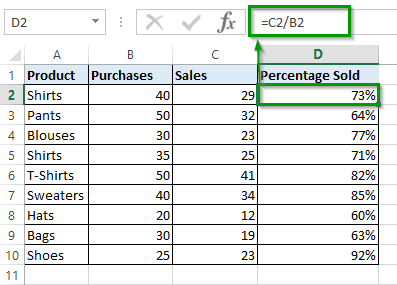5 Ways to Master Percentage Formulas in Excel

Mastering percentage formulas in Excel can significantly enhance your data analysis and reporting skills. Whether you're a student, professional, or business owner, understanding how to work with percentages is essential for making sense of financials, statistics, and many other data-driven insights. This post will guide you through five key methods to use and manipulate percentages in Excel, making you adept at handling various numerical scenarios with ease.
1. Understanding Basic Percentage Calculations


Excel can handle basic percentage calculations with simplicity. Here’s how to do it:
- To find the percentage of a number: Use the formula =A1*(B1/100), where A1 is the total and B1 is the percentage you want to calculate.
- To show a value as a percentage: Right-click the cell, choose “Format Cells,” and select “Percentage.”
These fundamental calculations form the backbone of more complex percentage operations in Excel.
2. Working with Percentages in Formulas


Excel’s strength lies in its ability to perform dynamic calculations. Here are some formulas to master:
- Percentage Increase: Use =((New Value - Original Value) / Original Value) * 100
- Percentage Decrease: Similar to increase, but with a negative sign at the beginning or use the formula =((Original Value - New Value) / Original Value) * 100
- Calculating Markup Percentage: =(Cost Price - Selling Price) / Cost Price * 100
- Profit Percentage: =(Profit / Cost Price) * 100
Remember to format the results as percentages using the “Format Cells” option or by typing “%” at the end of the formula.
3. Using Percentage Functions for Conditional Formatting


Conditional formatting can visually indicate how values relate to a percentage:
- Highlight Cells Greater Than: Choose “New Rule” from the Conditional Formatting menu, select “Use a formula to determine which cells to format,” and enter =A1>0.1 for highlighting cells that are greater than 10%.
- Data Bars or Color Scales: Select cells, go to “Conditional Formatting,” and apply the desired option to visually represent percentages.
This visual cue can help you quickly spot trends or anomalies in your data.
4. Creating Custom Percentages with Functions


Excel’s built-in functions can be combined to create custom percentage calculations:
- Percentage Change: To calculate percentage change over time, use =((Current Value - Previous Value) / Previous Value) * 100
- Percentage of Total: =(Part / Total) * 100 where Part is the subset of data and Total is the sum of the dataset.
- Using Functions: Functions like ROUND, IF, SUM, AVERAGE can be used to manipulate and display percentage data effectively.
Custom functions allow you to tailor calculations to your specific needs, enhancing the flexibility of Excel.
5. Advanced Tips for Percentage Manipulation


For those looking to push the limits of Excel:
- Using Array Formulas: These can calculate percentages for multiple values in a single formula, e.g., =((A1:A10 - B1:B10) / B1:B10) * 100
- Data Tables: Create data tables to calculate what-if scenarios for percentage changes.
- VBA Macros: Automate percentage calculations with VBA code for repeated tasks or complex processes.
📌 Note: While these advanced techniques provide powerful solutions, they also require a higher level of Excel expertise to implement effectively.
The journey to mastering percentage formulas in Excel involves understanding the basics, working with custom formulas, and utilizing advanced features like conditional formatting and array formulas. By practicing these methods, you can turn raw data into meaningful insights that drive decision-making, report generation, or simply help you understand the numerical impact of different scenarios. The key is to start simple, build upon your knowledge, and continuously explore the vast capabilities that Excel offers.
What are some common mistakes to avoid when working with percentages in Excel?

+
Common mistakes include not formatting cells as percentages, mixing up percentage increase and decrease formulas, not accounting for decimals when calculating with percentages, and forgetting to adjust for 100% when using custom functions.
How do I calculate compound percentage growth in Excel?

+
Use the formula =POWER(Ending Value / Beginning Value, 1/number of periods) - 1, where Ending Value is the final value, Beginning Value is the initial value, and number of periods is the number of compounding periods. Format the result as a percentage.
Can Excel calculate a percentage of a number range?

+
Yes, you can calculate a percentage of a range by using array formulas or SUMPRODUCT function, for example: =SUMPRODUCT((Range >= Lower Limit) * (Range <= Upper Limit)) / COUNT(Range).



